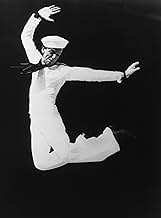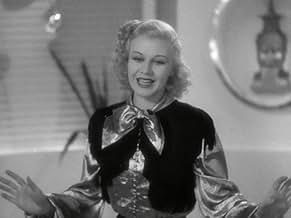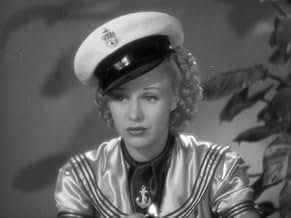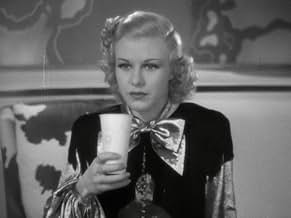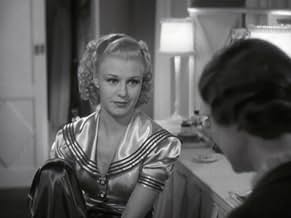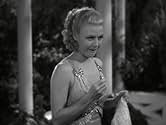IMDb-BEWERTUNG
7,1/10
4929
IHRE BEWERTUNG
Füge eine Handlung in deiner Sprache hinzuA Navy sailor tries to rekindle a romance with the woman he loves while on liberty in San Francisco.A Navy sailor tries to rekindle a romance with the woman he loves while on liberty in San Francisco.A Navy sailor tries to rekindle a romance with the woman he loves while on liberty in San Francisco.
- Auszeichnungen
- 4 Gewinne & 2 Nominierungen insgesamt
Harriet Nelson
- Connie Martin
- (as Harriet Hilliard)
Jean Acker
- Minor Role
- (Nicht genannt)
Richard Alexander
- Paradise Ballroom Waiter
- (Nicht genannt)
Constance Bergen
- Ticket Seller
- (Nicht genannt)
Frederic Blanchard
- Captain Jones
- (Nicht genannt)
Lynton Brent
- Deck Officer
- (Nicht genannt)
Phyllis Brooks
- Minor Role
- (Nicht genannt)
Tom Brower
- Policeman
- (Nicht genannt)
Empfohlene Bewertungen
Had this film been put together a tad better, it would be up there with the best of Astaire and Rogers. As it is, it's a fine movie but overly long with a tedious subplot, i.e., Randolph Scott romancing Rogers' sister, played by Harriet Hilliard (that's Ozzie Nelson's wife to you baby boomers).
Astaire and Scott are two Navy men. Scott meets Hilliard the first time when she looks like a stereotypical librarian, and later on after Ginger Rogers has asked her friend (a blond but unmistakable Lucille Ball) to glamor her up.
Meanwhile, Astaire tries to pick up where he and his old dancing partner left off. The result is some wonderful dance numbers, with Astaire and Rogers as a team as well as separately: "I'm Putting All My Eggs in One Basket," "Let Yourself Go," and "I'd Rather Lead the Band."
Hilliard is sweet but a little lethargic as a plain Jane turned glamor girl, although she sings her two songs well, "But Where Are You?" and "Get Thee Behind Me, Satan" - one poster didn't care for that song, but I love the title. Rogers is vivacious, and a youthful Astaire is a dynamo.
The highlight of the movie comes at the end with "Let's Face the Music and Dance," one of the most achingly beautiful songs ever written and certainly one of the most brilliantly executed by Rogers and Astaire. In it, they epitomize '30s glamor and fantasy. It is truly to be treasured and watched again and again.
Astaire and Scott are two Navy men. Scott meets Hilliard the first time when she looks like a stereotypical librarian, and later on after Ginger Rogers has asked her friend (a blond but unmistakable Lucille Ball) to glamor her up.
Meanwhile, Astaire tries to pick up where he and his old dancing partner left off. The result is some wonderful dance numbers, with Astaire and Rogers as a team as well as separately: "I'm Putting All My Eggs in One Basket," "Let Yourself Go," and "I'd Rather Lead the Band."
Hilliard is sweet but a little lethargic as a plain Jane turned glamor girl, although she sings her two songs well, "But Where Are You?" and "Get Thee Behind Me, Satan" - one poster didn't care for that song, but I love the title. Rogers is vivacious, and a youthful Astaire is a dynamo.
The highlight of the movie comes at the end with "Let's Face the Music and Dance," one of the most achingly beautiful songs ever written and certainly one of the most brilliantly executed by Rogers and Astaire. In it, they epitomize '30s glamor and fantasy. It is truly to be treasured and watched again and again.
Musically speaking Irving Berlin gave Fred Astaire and Ginger Rogers another pluperfect musical after Top Hat if that was possible. Although in this case like that Jerome Kern confection Roberta that they were in, Follow the Fleet retained Randolph Scott with another singer, this time Harriet Hilliard.
Randolph Scott is a career Navy CPO and Fred Astaire is an ex-vaudevillian who enlisted in the Navy to forget Ginger Rogers his former partner. But now the two are on shore leave. Fred and Ginger take up right where they left off, and Randy accidentally meets Ginger's dowdy sister Harriet who blossoms into a real beauty. But Randy's a typical love 'em and leave 'em sailor.
Again Irving Berlin wrote a hit filled score with him tightly supervising the production. Ginger gets to do some really outstanding vocalizing with Let Yourself Go which she and Fred later dance to. But the real hit of the show is Let's Face the Music and Dance which is a number done at a Navy show. Sung first by Astaire and later danced to by the pair, Let's Face the Music and Dance is one of the great romantic numbers ever written for the screen. Their dancing on this one is absolute magic.
I'm sure that when I mention Harriet Hilliard a few younger people might ask who that was. But they will know immediately when I mention her in conjunction with her famous husband Ozzie Nelson. That's right Ozzie and Harriet. It's something of a mystery to me why Harriet stopped singing when she just became David and Ricky's mom on television. Then again she didn't even keep her own name.
Neither Ozzie or Harriet sang on television. Ozzie was a pale imitation of Rudy Vallee as a singer, but Harriet could really carry a tune. She sings Get Thee Behind Me Satan and The Moon and I Are Here, But Where Are You, both with real feeling and class. I recommend you see Follow the Fleet if for no other reason than to hear a dimension of Harriet Hilliard incredibly forgotten today.
Randolph Scott is a career Navy CPO and Fred Astaire is an ex-vaudevillian who enlisted in the Navy to forget Ginger Rogers his former partner. But now the two are on shore leave. Fred and Ginger take up right where they left off, and Randy accidentally meets Ginger's dowdy sister Harriet who blossoms into a real beauty. But Randy's a typical love 'em and leave 'em sailor.
Again Irving Berlin wrote a hit filled score with him tightly supervising the production. Ginger gets to do some really outstanding vocalizing with Let Yourself Go which she and Fred later dance to. But the real hit of the show is Let's Face the Music and Dance which is a number done at a Navy show. Sung first by Astaire and later danced to by the pair, Let's Face the Music and Dance is one of the great romantic numbers ever written for the screen. Their dancing on this one is absolute magic.
I'm sure that when I mention Harriet Hilliard a few younger people might ask who that was. But they will know immediately when I mention her in conjunction with her famous husband Ozzie Nelson. That's right Ozzie and Harriet. It's something of a mystery to me why Harriet stopped singing when she just became David and Ricky's mom on television. Then again she didn't even keep her own name.
Neither Ozzie or Harriet sang on television. Ozzie was a pale imitation of Rudy Vallee as a singer, but Harriet could really carry a tune. She sings Get Thee Behind Me Satan and The Moon and I Are Here, But Where Are You, both with real feeling and class. I recommend you see Follow the Fleet if for no other reason than to hear a dimension of Harriet Hilliard incredibly forgotten today.
One of the best of the Fred Astaire and Giner Rogers films. Great music by Irving Berlin. Solid support from Randolph Scott, Harriet Nelson, Lucille Ball, Betty Grable, Frank Jenks, and Astrid Allwyn.
Terrific songs include "Let Yourself Go," "Let's Face the Music," and "Putting All My Eggs in One Basket." The last song is introduced by Astaire playing a jazzy piano and then a cute dance with Rogers. Rogers also sings "Let Yourself Go" with Grable among the backup singers.
Harriet Nelson (then Hilliard) sings two nice songs and plays Rogers' mousy sister. "Get Thee Behind Me" is a song that sticks with you for days. She also sings "But Where Are You?" Snappy and fast paced, this entry in the Astaire-Rogers series is one of the better ones. The classic and amazing beautiful finale, "Let's Face the Music and Dance" is among the best-known of their numbers. Rogers wears one of the great dresses in movie history.... a shimmering sequined number that swirls around her legs as she dances (weighted hem) and is also slightly see through. Just gorgeous. This is the number that Steve Martin and Bernadette Peters re-created in Pennies from Heaven.
Randolph Scott seems an odd choice as Astaire's pal but he also appeared in their Roberta with Irene Dunne. Luckily he does not attempt to sing or dance. It seems that Grable and Ball would have had bigger parts in 1936 but they have a few scenes and make little impact. Allwyn has the bigger role but is only OK.
Rogers has one of her best solo numbers in the series with "Let Yourself Go".... Jazzy and thumping, it's a great song.
Fun all the way, although I got tired of "We Joined the Navy" after the third time....
Terrific songs include "Let Yourself Go," "Let's Face the Music," and "Putting All My Eggs in One Basket." The last song is introduced by Astaire playing a jazzy piano and then a cute dance with Rogers. Rogers also sings "Let Yourself Go" with Grable among the backup singers.
Harriet Nelson (then Hilliard) sings two nice songs and plays Rogers' mousy sister. "Get Thee Behind Me" is a song that sticks with you for days. She also sings "But Where Are You?" Snappy and fast paced, this entry in the Astaire-Rogers series is one of the better ones. The classic and amazing beautiful finale, "Let's Face the Music and Dance" is among the best-known of their numbers. Rogers wears one of the great dresses in movie history.... a shimmering sequined number that swirls around her legs as she dances (weighted hem) and is also slightly see through. Just gorgeous. This is the number that Steve Martin and Bernadette Peters re-created in Pennies from Heaven.
Randolph Scott seems an odd choice as Astaire's pal but he also appeared in their Roberta with Irene Dunne. Luckily he does not attempt to sing or dance. It seems that Grable and Ball would have had bigger parts in 1936 but they have a few scenes and make little impact. Allwyn has the bigger role but is only OK.
Rogers has one of her best solo numbers in the series with "Let Yourself Go".... Jazzy and thumping, it's a great song.
Fun all the way, although I got tired of "We Joined the Navy" after the third time....
This is my all-time favorite Fred Astaire and Ginger Rogers film. The dialogue between the two is so cute and funny and very clever. Not to mention this film contains some of the best songs recorded by the two; like I'm Putting All My Eggs in One Basket and Let's Face the Music and Dance. If I remember correctly, this was the film that introduced me to Fred Astaire so I suppose because of that it will always hold a special place in my heart (sorry for the sentimental cr*p but I'm woman so get over it)All in all this film gets an 8/10 from me. The choreography was superb and also the fact that Lucille Ball is in it makes it even more awesome.
This film is nice because there are two love stories-- something of a plot departure, and the second couple (Randolph Scott and Harriet Hilliard Nelson) are given the bulk of the dramatics, which allow our stars to be looser, more comical. Astaire chews the gum a little too severely, but he was anxious to make a departure from his customary tuxedoed playboy. Rogers is much more at ease in the role of struggling dancer-singer, and plays well opposite sister Hilliard. (The history is that Ms. Hilliard had to darken her naturally blond hair to distinguish her from Ms. Rogers. But wouldn't they better resemble sisters if they were both blonds?) The Irving Berlin numbers are quite good, ranging from light and airy ("Let Yourself Go," "I'd Rather Lead A Band") to elegant ("Let's Face The Music And Dance"). This final number is the film's bewitching finale, performed on a lovely Art-Deco rooftop and illustrates Astaire's penchant for full-frame, single-take dancing. It is, in a nutshell, singularly gorgeous. The trivia history goes that Rogers' metallic thread gown had weights in the sleeves and hem to make the skirt wind and unwind; the dress was unintentionally difficult to perform in because its flared sleeves hit Astaire across the face IN THE FIRST TAKE- and after many re-shoots trying to cover it up, they ended up printing that first take (we have to assume that was apparently the best performance of the dance, but you can see the sleeves brush across Astaire's face). It loses one-half point from me, because Randolph Scott says 'bebby' once too often.
Wusstest du schon
- WissenswertesDuring the fight scene between Fred Astaire and Randolph Scott, Astaire - not skilled in movie fight scenes - accidentally bloodied Scott's nose; Astaire was mortified, but Scott remained pointedly nonchalant.
- Zitate
Sherry Martin: Look, why don't you let me try to fix you up? You'll be amazed how much better it will make you feel.
Connie Martin: Even though I'm not a blonde, I could be dumb, couldn't I?
Sherry Martin: And you'll probably do all right too. It takes a lot of brains to be dumb.
- VerbindungenFeatured in Fred Astaire: Puttin' on His Top Hat (1980)
- SoundtracksWe Saw the Sea
(uncredited)
Written by Irving Berlin
Played during the opening credits
Performed by Fred Astaire and chorus
[Also played as dance music]
Top-Auswahl
Melde dich zum Bewerten an und greife auf die Watchlist für personalisierte Empfehlungen zu.
- How long is Follow the Fleet?Powered by Alexa
Details
- Erscheinungsdatum
- Herkunftsland
- Sprachen
- Auch bekannt als
- Follow the Fleet
- Drehorte
- Produktionsfirma
- Weitere beteiligte Unternehmen bei IMDbPro anzeigen
Box Office
- Budget
- 747.000 $ (geschätzt)
- Laufzeit1 Stunde 50 Minuten
- Farbe
- Seitenverhältnis
- 1.37 : 1
Zu dieser Seite beitragen
Bearbeitung vorschlagen oder fehlenden Inhalt hinzufügen

Oberste Lücke
By what name was Marine gegen Liebeskummer (1936) officially released in India in English?
Antwort

